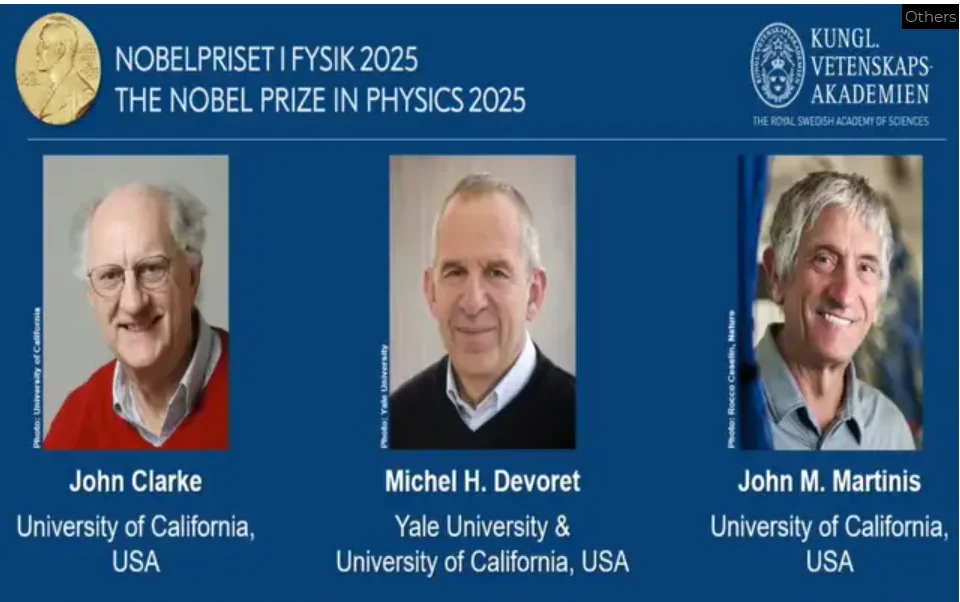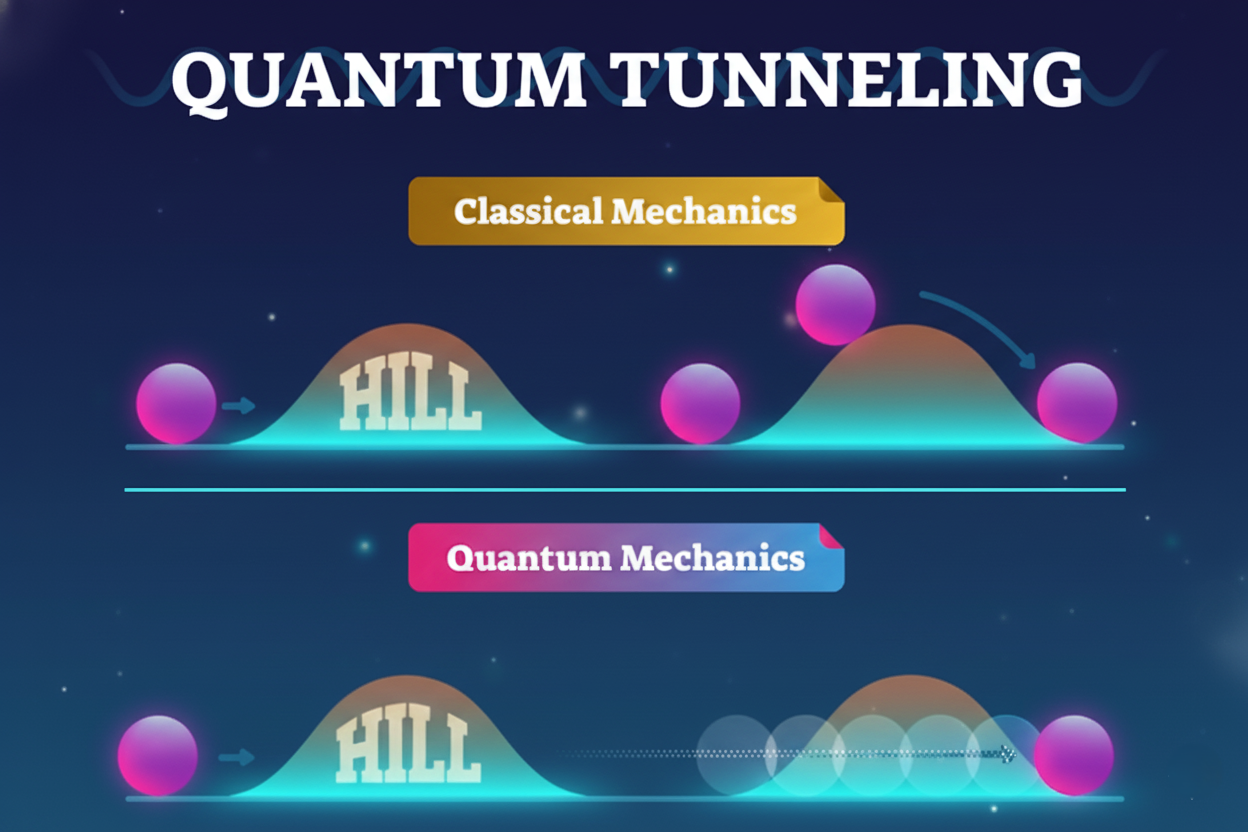Nobel Prize in Physics 2025 | 08 Oct 2025
Why in News?
The 2025 Nobel Prize in Physics has been awarded by the Royal Swedish Academy of Sciences to John Clarke, Michel Devoret, and John Martinis for their discovery of macroscopic quantum mechanical tunnelling and energy quantisation in an electric circuit.
- Their work has paved the way for superconducting circuits that could form the backbone of practical quantum computers and sensors, marking a major milestone in quantum technology.
What are the Key Highlights of the 2025 Nobel Prize in Physics?
- Macroscopic Quantum Tunnelling: The laureates extended quantum tunneling from microscopic scales to macroscopic systems, showing that large, visible systems (like superconducting circuits) could exhibit quantum behaviors like tunneling and energy quantization.
- They used superconducting materials and created a Josephson junction (superconducting system), where billions of Cooper pairs acted as a collective quantum object.
- When cooled to near absolute zero, they observed that the system’s electrical state could "tunnel" through energy barriers, exhibiting abrupt transitions, confirming quantum behavior over classical.
- They used superconducting materials and created a Josephson junction (superconducting system), where billions of Cooper pairs acted as a collective quantum object.
- Significance:
- Quantum Computing: Enabled the development of superconducting qubits and paved the way for advancements in quantum sensing and simulation.
- Cryptography Implications: Quantum computers could break encryption systems that rely on classical computation limits.
- Global Relevance: Countries, including India, are investing heavily in quantum technology; India’s National Quantum Computing Mission aims to develop functional quantum computers by 2031.
What is Quantum Tunnelling?
- About: Quantum tunneling refers to a phenomenon where particles can pass through barriers that, according to classical physics, would be impossible.
- Quantum tunneling occurs due to wave-particle duality, where particles behave as both waves and particles. When encountering a barrier, the particle's wave function extends beyond it, giving a probability of the particle appearing on the other side.
- Applications of Quantum Tunnelling:
- Scanning Tunnelling Microscope (STM): Uses quantum tunnelling to map surfaces at the atomic level.
- Flash Memory: Found in USB drives and SSDs. Data is stored in floating-gate transistors where electrons tunnel onto or off the gate.
- Josephson Junctions: Made of two superconductors separated by a thin insulator. Electrons tunnel across the barrier, creating a precise current-voltage relationship.
- Josephson Junctions are used in superconducting quantum computers and Superconducting Quantum Interference Devices (SQUIDs) for ultra-sensitive measurements.
- Quantum Computing: Quantum tunnelling enables qubits to exist in multiple states and transition between them. Essential for quantum algorithms that outperform classical computers in specific tasks.
- Nuclear Fusion: In stars and experimental reactors, tunnelling allows atomic nuclei to overcome repulsive forces and fuse. This process powers the Sun and holds potential for limitless clean energy.
Understanding Quantum Tunneling
Imagine rolling a ball up a hill:
- In classical physics, if the ball lacks enough energy, it rolls back and it can’t cross the hill.
- In quantum physics, due to the wave-like behavior of particles, there is a small probability that the ball appears on the other side of the hill (even without having enough energy to climb over it) as if it had "tunneled" through the barrier.
- This phenomenon is known as quantum tunneling.
What’s Really Happening?
- In quantum mechanics, particles like electrons act both as particles and waves.
- When a wave hits a barrier, part of it can "leak" through if the barrier is thin or low enough.
- This creates a probability that the particle will be found on the other side — without ever "climbing over" the barrier.
| Read more: Nobel Prize in Physiology or Medicine 2025 |
Frequently Asked Questions (FAQs)
1. What is Quantum Tunneling?
Quantum tunneling is a phenomenon in quantum physics where a particle moves through a barrier that it classically does not have enough energy to cross.
2. How does quantum tunneling occur?
Quantum tunneling occurs because quantum particles behave like waves that can extend beyond barriers, allowing a small probability of the particle appearing on the other side of the barrier, even without enough classical energy.
3. What is macroscopic quantum tunnelling?
It is the extension of quantum tunnelling to large systems, where collective particles in superconducting circuits exhibit quantum behaviour like tunnelling through energy barriers.
4. Who won the 2025 Nobel Prize in Physics and for what discovery?
John Clarke, Michel Devoret, and John Martinis (US) won for discovering macroscopic quantum mechanical tunnelling and energy quantisation in electric circuits.
5. What is Josephson Junction?
It’s a device made of two superconductors separated by a thin insulator where electrons can tunnel, forming the basis of superconducting qubits and quantum sensors.
6. How does quantum tunnelling enable quantum computing?
Tunnelling allows qubits to exist in superposition and transition between quantum states, enabling powerful computation beyond classical limits.
UPSC Civil Services Examination Previous Year Question (PYQ)
Prelims
Q. Which one of the following is the context in which the term "qubit" is mentioned?
(a) Cloud Services
(b) Quantum Computing
(c) Visible Light Communication Technologies
(d) Wireless Communication Technologies
Ans: (b)


